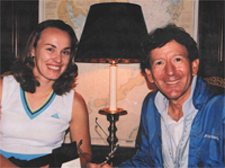Pat Cash on the Volley
Part 2
Interviewed by Paul Fein 2017
Do even superstars have flaws in their volleys?
Serena's volley is the one shot that prevented her from having even more domination. When she comes up against the top defenders, she is forced to finish the point off with a ground stroke where a good volley would work better.
Serena has her head too high above the racket and uses too much wrist on her forehand volley. At times she loses complete confidence in her net play.
A dedicated focus on improving her volleys for six months would work wonders for Serena and keep her in the game longer. Margaret Court, Billy Jean King, Martina Navratilova, and Steffi Graf were much better volleyers, as is Martina Hingis.
Federer's volley technique is slightly flawed. He tends to cut down too sharply and at times almost chops at the ball like a karate blow on the backhand. Federer also tends to lose the left arm behind him on the forehand which tends to introduce the wrist more than it should.
Sampras was also slightly choppy on the backhand volley, though not as pronounced as Federer's. But their ability to get themselves in the correct position very quickly pays off.
Should the traditional volley have a backswing against fast passing shots?
Against a fast passing shot, there is no time to take a full backswing. Do nothing much more than put your racket on to the ball unless you play a high level of tennis.
Attempt to give the ball the full racket face without trying to move the head of the racket. This is where a strong forearm and wrist are most advantageous.
Here is a rule of thumb: the less time you have to volley the oncoming ball, the shorter the distance your racket moves forward. For the average or typical volley, the racket travels forward about a foot.
Is equating, or using, a boxer's jab for the forward path of the volley swing the best analogy, or is catching a thrown ball with the palm of your hand?
I have never understood why coaches use the analogy of the boxer's jab or punch to teach the volley. This is a completely wrong technique for the volley because a punch or a jab requires elbow bend where the volley requires very little to no bend or flexion of the elbow. Most coaches have focused on the wrong area because the volley movement comes from the shoulder.
The movement for the forehand volley is more like in the old Western movies when the bartender slides a beer down the counter so smoothly that not one drop is spilled. The backhand volley is really like throwing a Frisbee. There is some elbow bend from time to time, but it is insignificant overall.
The arm is in a stronger position when slightly bent at contact on all shots in tennis. The only time you would use a straight arm is when you are on the full stretch. Of course, there are always exceptions. Rafael Nadal, who improvises a lot, has a straight arm sometimes, like them but a bent arm other times.
How does the height of the volley serve as a variable for the angle that the racket face is beveled?
When you volley above shoulder height, there is no, or almost no, tilt to the racket face. Below shoulder height, the tilt increases slightly and gradually, the lower the ball is. And below waist height, the tilt continues to increase slightly and gradually, the lower the ball is.
There is another variable for very low volleys. The closer to the net you are, the more you must tilt the racket face so the ball can rise up enough to clear the net.
The racket tilt is obviously a matter-of-degree learning process. For example, on low volleys, if you tilt the racket face too much, the ball will pop up too high and with too much underspin. On the other hand, if you don't tilt the racket face enough, it will go into the net. Through trial and error, you will fine tune your low volleys.
How does the height of the volley serve as a variable for the angle of the racket shaft?
For the highest volleys that are hit conventionally, the racket shaft is vertical. At shoulder height, the racket shaft is about a 45-degree angle. And at waist height, the racket shaft is horizontal or parallel to the court. Below waist height, the racket shaft stays parallel to the court as much as possible while the knees bend more or less depending on how low the oncoming ball and contact point are.
When is dropping the racket head acceptable?
You don't need to drop the racket head at all on low volleys above knee height. Instead, a player should bend his knees significantly when hitting low volleys. The first reason is you have better balance with a lower center of gravity. The second reason is visual. You see the ball better when your eyes are lower and closer to the line of flight of the oncoming ball.
What is the angle of the racket shaft on volleys below knee height?
You have to drop or lower the racket head sometimes, especially to volley very fast, dipping, low passing shots that even the social player sees more often these days. You just don't have the time to get your body down all the way and then recover in time for the next volley. I have also found that dropping the racket head works well with half volleys.
Where is the contact point for power volleys? For drop volleys?
Both types of volleys should be at about the same contact point. The forehand volley is usually contacted later--not as far in front of the body--than the backhand volley. One reason is that a player's shoulder is in a naturally strong position with the body behind the arm.
Remember the angle of the body is usually leaning forward and down because almost all volleys require slice. The arm on the volley, like the ground strokes, should be positioned not too far away from the body.
For most people, the backhand volley contact is about 30–45 cm (12-18 inches) in front and the forehand volley 20–35 cm (8-14 inches). The distance should approximate the handshaking position. If you get too close to or far from someone, you cannot shake hands properly.
When you volley, if the ball is too close to the body, you cannot swing cleanly through the shot. If it's too far away, you are over-stretching. Over-stretching would make a touch shot or drop volley very difficult. Therefore, your elbow should be 15–30 cm (6-12 inches) away from your body to enable the shoulder and arm to swing freely but still have control or to shake hands properly.
And like for ground strokes, a player should always attempt to hit the ball at the same distance from the body as much as possible. This will develop confidence and consistency of the swing. Mastering this alignment can be very difficult. It requires excellent quickness and hand-eye coordination.
When your racket contacts the ball, should the elbow be slightly bent on the forehand volley and not bent at all on the backhand volley?
Ideally, it should be slightly bent on both forehand and backhand volleys. As we know, it is not always possible to be in the perfect position at the net. More than any other shot, the volley needs last-second adaptations.
I have a very clear vision of Tony Roche hitting his famous backhand volley from almost any position, especially when it was coming way over to the forehand side of his body. He learned to adapt to any situation. The backhand volley is the better shot to hit when the ball is coming fast at your torso or legs and you can't get your body out of the way in time.
How long should the followthrough be? Should the followthrough be longer for volleys hit near the service line?
The backswing and followthrough very much depend on what type of volley you have to hit and the speed and trajectory of the ball coming towards you. If it is fast and low, not much more than push through the ball would be sufficient. But if the ball is floating and high around the service line, a bigger backswing and follow-through are required.
On the high backhand volley, should the racket end up at the same height where the ball is contacted?
First, let's describe the height zones. The high zone is above the shoulders. The medium zone is from the waist to the shoulders. And the low zone is below the waist. The volley followthrough is the same as groundstrokes in some respects. The highest volley, of course, is the smash, and like the serve, its followthrough is sharply downwards.
The opposite is true for the very low volley, though it's not a drastically sharp upwards movement because that will create a pop-up volley. But for most volleys between the chest and the waist, a reasonably level or parallel followthrough with some rotation of the shoulders and arm is good.





